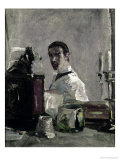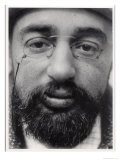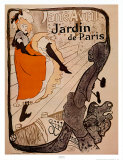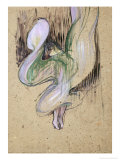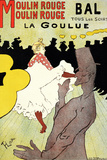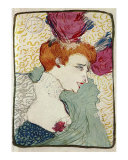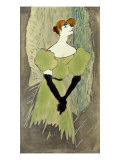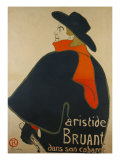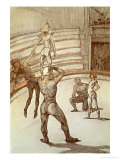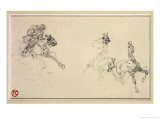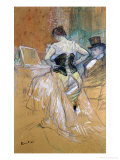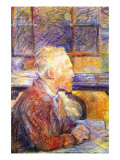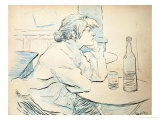Henri de Toulouse-Lautrec Posters, Books, Video, Links for Learning
|
|||||||||||||||||||||||||||||||||||||||||||||||||||||||||||||||||||||||||||||||
|
art history > Post-Impressionist > HENRI de TOULOUSE-LAUTREC < famous men < social studies |
|||||||||||||||||||||||||||||||||||||||||||||||||||||||||||||||||||||||||||||||
|
Count Henri de Toulouse-Lautrec Henri de Toulouse-Lautrec was a post-impressionist painter and art nouveau illustrator. He was declared the "soul of Montmartre" for his intensely lurid colored posters and paintings depicting the music halls and intimate lives of this Parisian quarter during the Belle Epoque (Fr = Beautiful Era) era. Henri de Toulouse-Lautrec was born an aristocrat, into a closely knit noble family, the Counts of Toulouse (his parents were first cousins). Due to a rare bone disease Lautrec's leg bones broke easily and did not heal properly from childhood accidents; as an adult he had a normal sized torso and stunted legs, giving his the illusion of being a dwarf. It was a combination of his talent for observation and drawing, which his parents supported with lessons and a studio, and his deformity which kept him from being a full participant in the lives around him, that he was able to capture and master the expression of the steamy Paris night life.
Toulouse-Lautrec had early academic training and particularly admired the Impressionist Edgar Degas. While Degas depicted the backstage of the ballet stage, Toulouse-Lautrec may have felt less conspicuous with his physical deformity around people who also did not "fit in" - they were deformed with garish make-up and seemed to grimace in Lautrec's portraits. Eventually Lautrec self medicated himself with alcohol against their ridecule - one of the people he repeatedly portrayed said, "I asked him to come along because I wanted to frighten off anyone who might try to accost me", La Goulue, on spending the day in Lautrec's company in the Bois de Boulogne. Fortunately his skill and innovation in the art of lithography was well suited to the advertising necessary for Paris night life and he had considerable commercial success. In 1898 Lautrec's alcoholism caused his family to send him to a private sanatorium, in that recuperation time he worked on a series of circus drawings. Though he was able to return to his studio for a time, he became partially paralyzed before his death. |
|||||||||||||||||||||||||||||||||||||||||||||||||||||||||||||||||||||||||||||||
“I have tried to do what is true and not ideal.” “Love is when the desire to be desired takes you so badly that you feel you could die of it.” Books : Henri de Toulouse-LautrecToulouse-Lautrec and Montmartre - Childhood illness and injuries steered Toulouse-Lautrec away from customary rural aristocratic avocations and toward a profession as an artist. He became a painter, draftsman, and lithographer whose work was immersed in famously hedonistic, fin-de-siècle Paris. In his hands, advertising posters were raised to a high art; he portrayed the nightlife of Montmartre-circuses, cafés, dance halls, and brothels-with clear, bold color and a certain seamy panache that is instantly recognizable as his. His much mythologized life has found its way into many biographies and into two feature-length movies called Moulin Rouge. (book description) 370 color plates of Toulouse-Lautrec and his contemporaries; companion book to exhibition of the same name at the National Gallery of Art and the Art Institute of Chicago. Toulouse-Lautrec and Montmartre - DVD Toulouse-Lautrec: The Moulin Rouge and the City of Light - Grades 4-8 biography of French artist best known today for his vibrant and much-loved posters. Along with explaining the development of the poster medium, the book tells the moving tale of how Lautrec triumphed over a crippling childhood disease to become a popular artist in his day. The book is illustrated with gorgeous reproductions of his paintings, posters, and drawings, ranging from childhood sketches, to portraits of performers at the famous Moulin Rouge, to circus themes. Contemporary photographs of Lautrec and his friends bring the story to life. (book description) The Drawings of Toulouse-Lautrec - Longstreet Toulouse-Lautrec Art Activity Pack - Color Your Own Toulouse-Lautrec Masterpieces - (Ages 9-12) Thirty of the great post-Impressionist's most famous works — including The Jockey; Jane Avril; and Moulin Rouge, La Goulue — fill this collection. Colorists can re-create or modify with their own hues masterpieces that capture lively scenes from circuses, dance halls, nightclubs, racetracks, and other spectacles. (book description) Toulouse-Lautrec's The Circus: Thirty-Nine Crayon Drawings in Color - These kaleidoscopic visions from the big top offer a series of post-Impressionistic sideshows, courtesy of brilliant drawings by Toulouse-Lautrec. Masterpieces of composition and movement include “The Rearing Horse,” “The Jockey,” and “The Animal-trainer.” (book description) Henry de Toulouse Lautrec, Woman as Myth: Woman as Myth (exhibition catalogue) - The Letters of Henri de Toulouse-Lautrec - Collected here for the first time in a full edition, the letters of Henri de Toulouse-Lautrec . . . all the known extant correspondence . . spanning his entire life . . . from the bright optimism of his conventional, aristocratic childhood, through the years when he was an avant-garde artist at the height of his powers, to his tragic deterioration, breakdown, and early death. The letters are rich in factual data, and contain numerous art historical revelations. English translation of French original. Montmarte Note Card set (boxed) - From the mid-nineteenth century until the onset of the First World War, the steep hill called Montmartre was a magnet that attracted the full spectrum of Parisian society. Known for its windmills (moulins), the neighborhood had a reputation as a home to the artistic, the bohemian, and the risqué. The dancer La Goulue drew crowds to the open-air dance floor at Moulin de la Galette; the singer Aristide Bruant scandalized the more polite visitors to the Moulin Rouge with his scabrous social satire. Roughnecks preyed on the affluent and inobservant. LINKS FOR LEARNING : HENRI DE TOULOUSE-LAUTREC
|
|||||||||||||||||||||||||||||||||||||||||||||||||||||||||||||||||||||||||||||||
|
previous page | top |
|
|
|
NPW home | Global PathMarker Collection | APWTW Blog | faqs-about | contact | search | privacy |
|
NetPosterWorks.com ©2007-2015 The Creative Process, LLC All Rights Reserved. |
last updated






